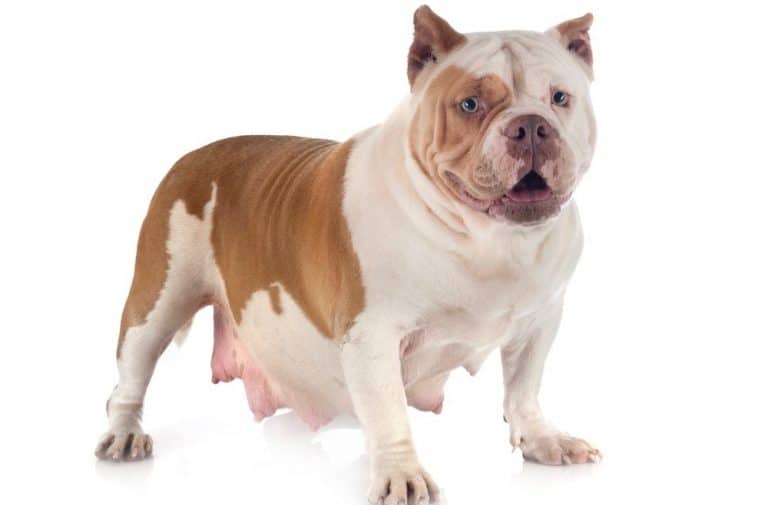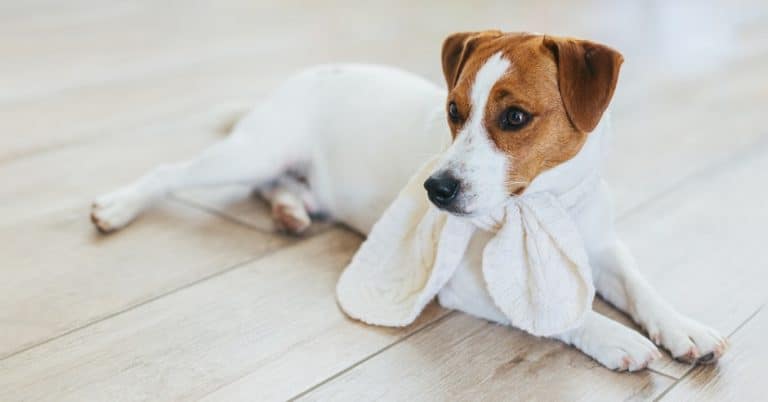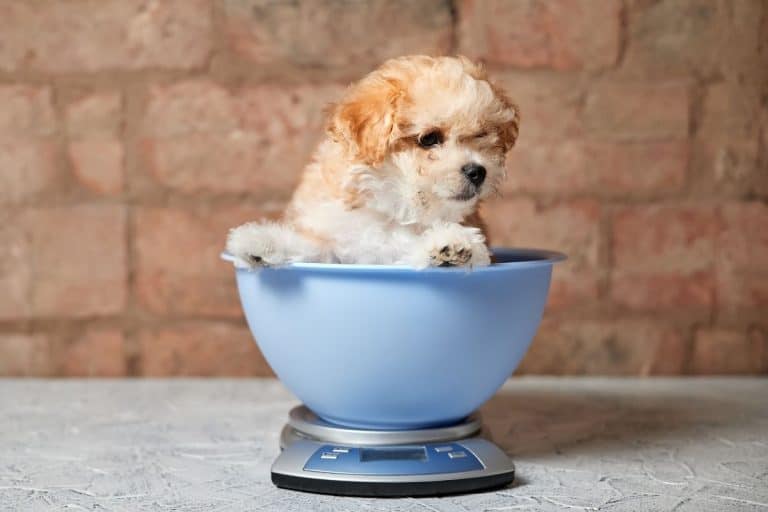Dog Poop Stuck In Bum – Poop Hanging Out Of Dog’s Bum
Naturally, the digestive system of dogs is very strong and unless they suffer from an illness or are fed things that are not good for them, they should eliminate healthy stools and they should not have a hard time doing so.
As a dog owner, you have probably gone to the vet and told them that ‘my dog has poop stuck in bum’ and want their advice.
There are various reasons why poop can get stuck in your dog’s bum.
The main one is constipation, and the others include digestive blockages, difficulty passing out a foreign substance, injury, and the poo being matted in the hair near the bum.
The process of solving this issue is being prepared to get dirty as it involves the use of gloves and paper towels. If you cannot be able to do this, take your dog to the vet immediately for extraction.
This article will provide you with information about why dog poop gets stuck in the bum and how you can help your dog.
Why Does My Dog’s Poop Get Stuck?
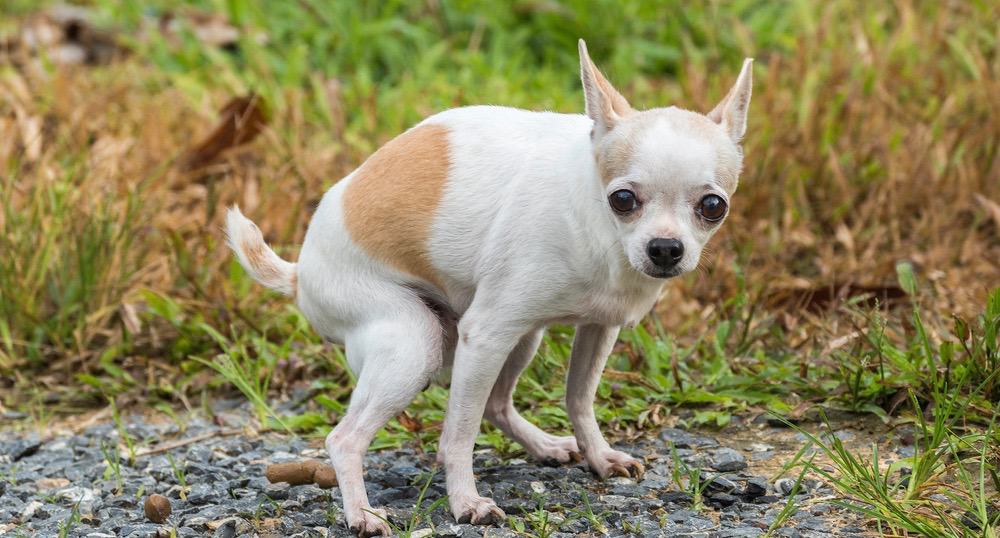
The following are the common reasons why your dog can have poop stuck in their bum:
1. Constipation
This is the most common and number one reason why your dog may end up with poop stuck in the bum. Dogs experience constipation when they are not able to poop well on a regular schedule.
They may strain a lot in producing poop that is like little, dark-brown rocks which may end up being stuck in the bum or even unable to poop at all.
So, what is the cause of constipation? Normally, as the fecal matter moves along the dog’s digestive tract, the electrolytes and water contained in it are reabsorbed by the colon.
However, if the travel time is impaired or slow for any reason, the colon will continue absorbing the moisture. As it loses more moisture, the matter becomes drier, harder, and the dog will have difficulty passing it.
Since the digestive process is directly connected to moisture and hydration, there is a high chance that dehydration is a major cause of constipation.
However, there are other reasons for constipation in dogs including the following:
Diet
Often, a dog’s diet does not have fiber. Also, dogs tend to eat objects that are not edible such as tree bark, squeakers, as well as duct tape.
All of this leads to abnormal fecal movements or blockages in the intestines. Calcium sources like bones can also cause constipation.

Age
Senior dogs have a high chance of being constipated because their digestive system may not be as strong as when they were younger.
Lifestyle habits
A more sedentary lifestyle and lack of exercise slow down the digestive process leading to constipation.
Electrolyte Disparities
your dog requires electrolytes for optimal hydration and health. Electrolytes such as sodium, potassium, chloride, phosphorus, and magnesium maintain the water level, hence preventing constipation. They also regulate nerve and muscle activity as well as balance the pH of the blood.
Illnesses
Certain health conditions can cause your dog to have difficulty when defecating.
They include psychological problems, metabolic disease, tumors in the pelvic region and digestive tract, kidney disease, enlarged prostate, hernias, slow digestion, orthopedic disorders, dysfunction of the central nervous system, and spinal issues.
If your dog is not releasing stool as they should, the following are ways to prevent constipation which will, in turn, improve your dog’s pooping:
Give your dog enough water to drink. If your dog doesn’t like drinking water, you can add ice cubes to the water for them to chew on or add collagen-rich bone broth to add flavor.
Add plain pumpkin or sweet potato to their normal food because they are high in fiber. Since pumpkin is high in both moisture and fiber, it is effective with digestive issues. Powdered fiber supplements and figs can also help treat constipation.
Instead of dry kibble, give your dog canned wet food. Wet food helps in hydrating your dog because it has high moisture content and it also provides them with their daily vitamin and mineral needs.
Give your dog a teaspoon of mineral oil by mixing it with their food. It is recommended that you use 1 tablespoon for every 11 pounds of dog’s weight.
Always mix the oil with the food, do not give them orally because it can cause pneumonia if it ends up in the lungs.
Do not allow your dog to munch on grass and small pieces of bones.
When to Go to the Vet
If your dog is still constipated after doing all the above, take them to the vet for assessment. Your vet will do abdominal ultrasound, radiographs, and bloodwork to identify the underlying cause. If there is an obstruction, your vet will remove it.
To ensure that your dog is hydrated, your vet will administer fluids under their skin, but in severe cases, the fluids can be administered intravenously.
If your dog has not been neutered and the prostate is causing constipation, then castration is the best option.
2. Pseudocoprostasis
Pseudocoprostasis is a condition that happens when the anal opening is blocked by dried feces that on the fur and could be the reason why poop is stuck in your dog’s bum.
This condition occurs because of a few reasons such as when dogs have diarrhea or soft stool that can stick to the fur making it matted.
Additionally, dogs that are not well-groomed by their owners, cannot groom themselves well enough, shed a lot because of illnesses such as hypothyroidism, or those prone to matted fur are likely to develop this condition.
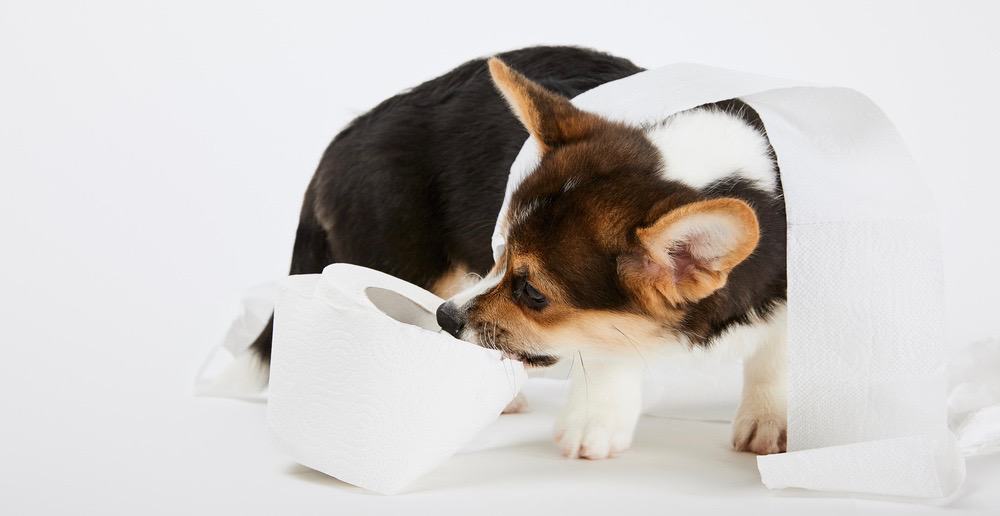
Once the matted hair and feces have obstructed and covered the anal opening, it becomes difficult for additional feces to pass, and this can be a painful experience for your dog.
Since the fecal matter is in constant contact with the skin, it can lead to skin infections and irritations. If this is not treated, flies can easily lay eggs on the poop causing maggot infestation of the anal region.
Symptoms
The symptoms that you should watch out for include scooting the bottom across the floor, straining to defecate, poor appetite, vomiting, foul or fecal odor, lethargy, and presence of matted hair around the anus.
Diagnosis
The diagnosis of this condition is based on the findings of a physical examination. A large hair mass and fecal matter obstructing the anal opening is a clear indication.
Treatment
The solution to removing your dog’s matted mass is to clip the fecal material and fur away thoroughly but gently from the anus and the surrounding region.
Then, gently clean the affected skin using a mild dog shampoo and rinse it thoroughly before patting it dry.
To help heal the area, apply a light coat of antibiotic ointment, and avoid using ointments that contain zinc oxide because it can cause anemia if your dog ingests this product.
Avoid using scissors because you are likely to cause a sizable laceration as the matted mess is tightly bound to the anus and skin. This should be done at the vet clinic or by an expert groomer.
Follow the same hygienic guidelines that your vet would if you decide to clean your dog at home. This includes using disposable gloves and throwaway fabric towels or soft paper. Also, call your vet first to seek advice before starting the process.
After all the cleaning is done, take your dog to the vet to assess for any additional issues such as the skin could be possibly ulcered or significantly inflamed and may need anti-inflammatory medications or antibiotics from the vet.
Your vet may also recommend the Elizabethan collar to prevent your dog from licking the affected area.
Prevention
The best to prevent this condition from happening is to address the root cause of diarrhea or soft stool. Your vet should perform a complete fecal examination and he or she may prescribe a diet or medication to help normalize the stool.
Thorough and regular grooming of all parts of your dog including the anal sacks and ears should be part of a healthcare routine.
Use baby wipes to clean the anal area in between the grooming appointments. If you take your dog to regular grooming, request the groomer to trim the hair surrounding the anus for better health.
Additionally, keep an eye on your dog’s stool to make sure that it is normal and healthy. If your dog is furry, observe their defecation and check their anus daily to ensure that nothing is stuck in the anus.
Also, if your dog is suffering from diarrhea, pay more attention to their anus and wipe any adhered stool using a baby wipe or toilet paper.
3. Digestive Blockage (Megacolon/Obstipation)
Untreated constipation and leaving your dog to continue struggling passing out stool without intervening can lead to obstipation.
This means that the fecal matter is too hard to be moved leading to a blockage in the colon. When poo is stuck in the colon, it creates a disease that damages the nerves in the colon making the large intestines lose control.
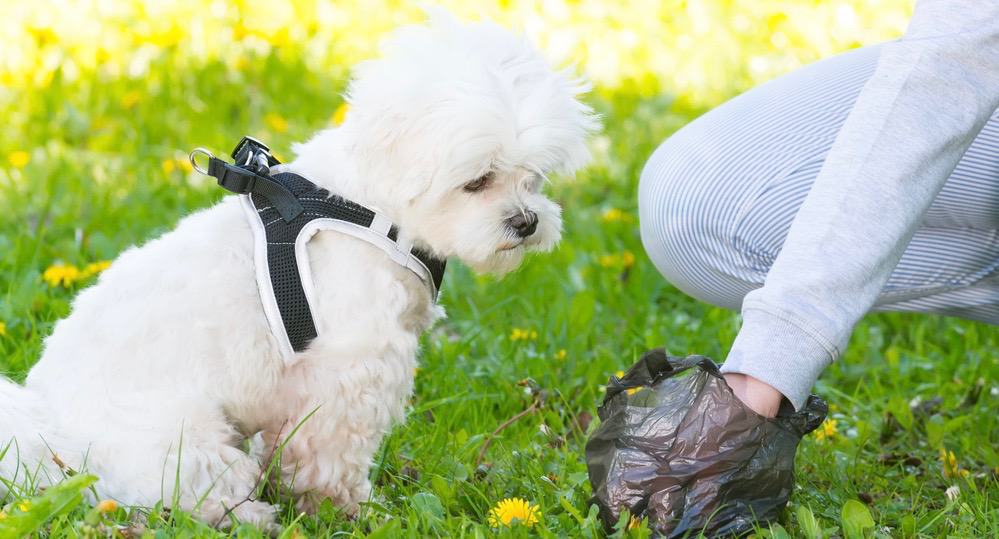
This condition is like constipation, but it is more painful and uncomfortable for your dog. Your dog may not want to eat but lay down as any movement can lead to sharp pains.
Obstipation is not likely to go away on its own and it needs medicinal treatment and veterinarian attention.
Symptoms
If your dog is suffering from a digestive blockage, they will show similar symptoms as constipation along with lack of appetite, weight loss, and increased and visible signs of pain.
Treatment
Treating obstipation often needs surgery to remove the blockages and directly treat the colon.
But, because of the risks and high costs involved, vets often recommend giving your dog lots of water, changing their diet to include fiber, and doing routine exercise so that bowel movements can be stimulated.
4. Inability To Pass A Foreign Object
If your dog has swallowed a foreign solid object that cannot be digested and moved along the colon, it will cause a blockage which leads to constipation and later obstipation.
This can be severe if the object is sharp such as glass as it can cut the walls of the digestive tract causing higher levels of pain.
Symptoms
The signs to watch out for if your dog has ingested a foreign body are like those of obstipation and constipation along with a reluctance to move, yelping as well as severe pain, and straining to poo.
Treatment
If your dog is in severe pain and you think that it is caused by a foreign object stuck in their stomach, take them to the vet immediately as the object could be causing damage.
5. Arthritis/Joint Problems/Injury
Whichever the breed, dogs always squat when defecating because it is the most comfortable and efficient position to do it. If your dog is having difficulty squatting, he will find it hard to poop.
The main reason why your dog may not be able to squat properly is joint problems, arthritis, or an injury that is not healed.
It takes effort to squat and can strain your dog’s legs and muscles.
Symptoms
If your dog show signs such as reduced mobility, lack of appetite, limping while walking, and visible struggle to squat, then they may be having issues with their joints, have arthritis, or an injury.
Treatment
If your dog has an injury, take them to the vet for a check-up and it will heal on its own if it is not severe. However, joint problems and can stick around and become worse with time.
Your vet can recommend steps you can take to manage and slow them down such as a more comfortable bed, joint supplements, and adequate exercise as the cartilage can quickly harden without it.
Can You Pull Poop Out Of A Dog?
Yes, you can pull the poop out of your dog’s bum, and it is recommended in most cases instead of just leaving it to hang.
However, you should be very gentle when doing it because the anal area is a sensitive part of your dog’s body.
If you roughly pull the poop, you could seriously hurt your dog and cause internal bleeding. The risk of this happening is high if a visible rope or string is connecting the poop.
In these situations, first, pull it gently to see whether the materials come out. If there is any painful reaction or any resistance, cut it with scissors and let your dog pass the rest on their own time.
If your dog has not passed the material after a while, take them to the vet because the material could be twisted and wrapped up in their lower intestines.
Pulling the string or the rope too hard puts pressure on the dog’s internal organs which can cut the circulation off leading to serious internal damage.
Ways To Remove Stuck Dog Poop

The following are recommended ways to get the stuck poop out of your dog’s bum. Remember to wear your gloves and layout paper towels because it’s going to be close and personal:
The Warm Bath Method
Immersing your dog in a warm water bath is one of the easiest ways to remove feces in their bum. Warm water loosens and softens the poop easing the removal when you let the dog sit in the water for some time.
If there is poop stuck in the surrounding long hair, lather and wash it up with a dog shampoo for sensitive skin.
This method will help remove most of the stuck hair. Cut off the long fur afterward so that feces do not get stuck again.
The Simple Pull Method
It is as simple as the name. Apply some Vaseline or a lubricant around the sides generously and pull gently the feces out.
If the poop is hard, dig your fingers a little bit in. If this is uncomfortable for you or it seems to cause pain to your dog, visit your vet to help you out with it.
The Bowel Express Method
Grasp the area encircling the dog’s bum using your index, thumb, and middle finger and massage the area in an outward motion to trigger the pooping action. It is helpful to apply lubricants to the area beforehand.
This action will stimulate the rectal muscles making them work harder causing the excretion of the poop after about five pulling motions.
The Spray Method
This method stimulates the anus of the dog to contract so that it triggers bowel movement.
You can use water mixed with antiseptic or cool water to spray the dog’s bum until the sphincter starts puckering. Then gently wipe the area with a moist baby wipe in a round motion to help the dog release the remaining poop.
The Finger Swab Method
This method needs a cotton swab. Inserting a lubricated gloved pinky finger or a cotton swab has proved to elicit defecation responses even in paralyzed animals. Ensure to gently insert only the tip of the finger or the swab.
The Squeeze Method
This is an effective method that allows you to feel what caused your dog’s anal blockage. Use your fingertips to gently press the circular area around the bum.
You may find a solid texture around the rectum that has been making your dog’s defecation difficult.
Pressing your index finger and thumb inwards on either side of the rectum, grip the feces through the skin.
When you get a hold of it, pinch the hardened poop firmly to break it off, this opens the anus simultaneously enabling the stool to naturally come out.
Do not pinch hard to avoid damaging the colon and rectum lining. You can repeat the action until the stool is all out and the tissues surrounding the bum become soft again.
What Gloves Should I Use to Remove the Poop?
If you are removing the poop, wear a glove and sanitize your hands to avoid infections. Finding the correct glove can be hard. Therefore, the following features will give you an ideal glove you can use for this process:
- Disposable to prevent potential contaminations and infections.
- Vinyl or nitrile. Latex or plastic can also work but considering the quality, vinyl or nitrile is recommended.
- Thin to enable flexible movement.
- Does not have powder.
Final Words
If poop is stuck in your dog’s bum, use the methods mentioned above to remove it and ensure that you do it gently. If it is not possible, take them to the vet for assistance.
You can prevent the whole poop hanging out of my dog’s bum issue from happening in the future by feeding your dog fiber-rich food, exercising them, and making them drink plenty of water.


